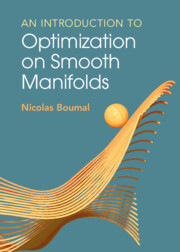Refine search
Actions for selected content:
6791 results in Communications and signal processing
11 - Geodesic convexity
-
- Book:
- An Introduction to Optimization on Smooth Manifolds
- Published online:
- 09 March 2023
- Print publication:
- 16 March 2023, pp 298-320
-
- Chapter
- Export citation
Preface
-
- Book:
- An Introduction to Optimization on Smooth Manifolds
- Published online:
- 09 March 2023
- Print publication:
- 16 March 2023, pp xi-xv
-
- Chapter
- Export citation
2 - Modulation and Demodulation
-
- Book:
- Introduction to Digital Communications
- Published online:
- 24 April 2023
- Print publication:
- 16 March 2023, pp 46-142
-
- Chapter
- Export citation
3 - Embedded geometry: first order
-
- Book:
- An Introduction to Optimization on Smooth Manifolds
- Published online:
- 09 March 2023
- Print publication:
- 16 March 2023, pp 16-50
-
- Chapter
- Export citation
Appendix C: - Finite Fields and BCH Codes
-
- Book:
- Introduction to Digital Communications
- Published online:
- 24 April 2023
- Print publication:
- 16 March 2023, pp 618-623
-
- Chapter
- Export citation
Preface
-
- Book:
- Introduction to Digital Communications
- Published online:
- 24 April 2023
- Print publication:
- 16 March 2023, pp xi-xiii
-
- Chapter
- Export citation
6 - Second-order optimization algorithms
-
- Book:
- An Introduction to Optimization on Smooth Manifolds
- Published online:
- 09 March 2023
- Print publication:
- 16 March 2023, pp 115-148
-
- Chapter
- Export citation
8 - Block Codes
-
- Book:
- Introduction to Digital Communications
- Published online:
- 24 April 2023
- Print publication:
- 16 March 2023, pp 433-556
-
- Chapter
- Export citation

An Introduction to Optimization on Smooth Manifolds
-
- Published online:
- 09 March 2023
- Print publication:
- 16 March 2023

Inference and Learning from Data
- Learning
-
- Published online:
- 24 February 2023
- Print publication:
- 22 December 2022
-
- Textbook
- Export citation

Inference and Learning from Data
- Foundations
-
- Published online:
- 17 February 2023
- Print publication:
- 22 December 2022
-
- Textbook
- Export citation
Index
-
- Book:
- Age of Information
- Published online:
- 02 February 2023
- Print publication:
- 09 February 2023, pp 478-482
-
- Chapter
- Export citation
18 - UAV-Assisted Status Updates
-
-
- Book:
- Age of Information
- Published online:
- 02 February 2023
- Print publication:
- 09 February 2023, pp 456-477
-
- Chapter
- Export citation
4 - Controlling the Age of Information: Buffer Size, Deadlines, and Packet Management
-
-
- Book:
- Age of Information
- Published online:
- 02 February 2023
- Print publication:
- 09 February 2023, pp 89-114
-
- Chapter
- Export citation
Acknowledgments
-
- Book:
- Age of Information
- Published online:
- 02 February 2023
- Print publication:
- 09 February 2023, pp xii-xii
-
- Chapter
- Export citation
2 - On the Distribution of AoI
-
-
- Book:
- Age of Information
- Published online:
- 02 February 2023
- Print publication:
- 09 February 2023, pp 36-58
-
- Chapter
- Export citation
17 - Economics of Fresh Data Trading
-
-
- Book:
- Age of Information
- Published online:
- 02 February 2023
- Print publication:
- 09 February 2023, pp 429-455
-
- Chapter
- Export citation
16 - Transmission Preemption for Information Freshness Optimization
-
-
- Book:
- Age of Information
- Published online:
- 02 February 2023
- Print publication:
- 09 February 2023, pp 406-428
-
- Chapter
- Export citation
14 - Information Freshness in Large-Scale Wireless Networks: A Stochastic Geometry Approach
-
-
- Book:
- Age of Information
- Published online:
- 02 February 2023
- Print publication:
- 09 February 2023, pp 364-383
-
- Chapter
- Export citation
5 - Timely Status Updating via Packet Management in Multisource Systems
-
-
- Book:
- Age of Information
- Published online:
- 02 February 2023
- Print publication:
- 09 February 2023, pp 115-139
-
- Chapter
- Export citation
